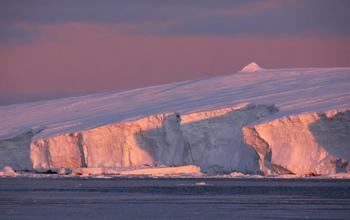

Sunset on the Sabrina Coast, East Antarctica.
Credit: Steffen Saustraup, University of Texas Institute for Geophysics
The East Antarctic Ice Sheet locks away enough water to raise sea level an estimated 53 meters (174 feet), more than any other ice sheet on the planet. It's also thought to be among the most stable, not gaining or losing mass even as ice sheets in West Antarctica and Greenland shrink.
But new research, led by The University of Texas at Austin and the University of South Florida (USF) and funded by the National Science Foundation (NSF), found that the East Antarctic Ice Sheet may not be as stable as it seems.
In fact, the ice sheet has a long history of expanding and shrinking — a finding that indicates the ice sheet may contribute substantially to global sea-level rise as Earth's climate warms. The new results came from geophysical and geologic data collected during the first-ever oceanographic survey of East Antarctica's Sabrina Coast. The glaciers in this region may be particularly susceptible to climate change because they flow from the Aurora Basin, a region of East Antarctica that lies mostly below sea level.
Co-lead author Sean Gulick, a research professor at the University of Texas Institute for Geophysics (UTIG) and the university's Department of Geological Sciences, said the study found that glaciers from the Aurora Basin have been stable for only the last few million years.
“It turns out that for much of the East Antarctic Ice Sheet's history, it was not, as commonly perceived, a large, stable ice sheet that underwent only minor changes in size over millions of years,” he said. “Rather, we have evidence for a very dynamic ice sheet that grew and shrank significantly between glacial and interglacial periods. There were also frequent long intervals of open water along the Sabrina Coast, with limited glacial influence.”
NSF's Office of Polar Programs (OPP) manages the United States Antarctic Program and provided the funding and logistical support that made field research to the Sabrina Coast possible.
“The past behavior and dynamics of the Antarctic ice sheets are among the most important open questions in the scientific understanding of how the polar regions help to regulate global climate,” said Jennifer Burns, director of OPP's Antarctic Integrated Science System Program. “This research provides an important piece to help solve that massive puzzle.”
The findings were published on Dec. 14 in the journal Nature. Collaborators include researchers at Louisiana State University (LSU), the University of Southampton, Florida State University and Colgate University.
Using marine seismic technology deployed from an ice breaker, researchers were able to reconstruct how glaciers on the Sabrina Coast have advanced and retreated over the past 50 million years. The team also took core samples of mud from 1 to 2 meters below the seafloor and analyzed ancient pollen to determine the age of the samples. The analysis was conducted at LSU's Center for Excellence in Palynology.
The Sabrina Coast and nearby Aurora Basin are particularly important because regional glaciers are now thinning and retreating as nearby ocean waters warm. If the ice sheet in the Aurora Basin melted, global sea levels would rise more than 3-5 meters (10-15 feet).
According to the team's data, ice advanced from the Aurora Basin and retreated again at least 11 times over the first 20 million years of the ice sheet's history. Researchers also found that the young ice sheet was much wetter than it is today, with meltwater from the surface flowing into a network of channels beneath the ice. These channels were eroded into the rock below the ice, leaving distinctive formations known as “tunnel valleys.” This dynamic time for East Antarctic glaciers occurred when atmospheric temperatures and atmospheric carbon dioxide levels were similar to or higher than present day levels.
“We shouldn't view this as one ice sheet that suddenly grew to its present size, but rather as one that was a transient ice sheet that expanded every couple million years or so,” Gulick said.
Around 6 million years ago, the East Antarctic Ice Sheet expanded, stabilized and ceased producing large volumes of meltwater. However, as climate change raises global air temperatures, it is possible that East Antarctic glaciers could start melting, a change that could make the ice sheet shift back into unstable territory.
The warm ocean water now melting Totten Glacier — East Antarctica's largest glacier, which flows from the Aurora Basin — could be an early warning sign, said co-lead author Amelia Shevenell, an associate professor in USF's College of Marine Science.
“A lot of what we are seeing right now in the coastal regions is that warming ocean waters are melting Antarctica's glaciers and ice shelves, but this process may just be the beginning,” Shevenell said. “Once you have that combination of ocean heat and atmospheric heat — which are related — that's when the ice sheet could really experience dramatic ice mass loss.”












